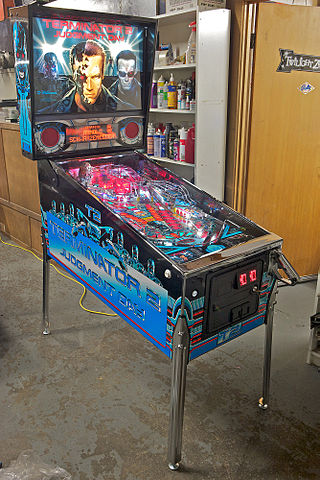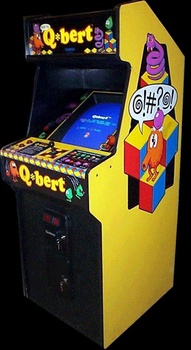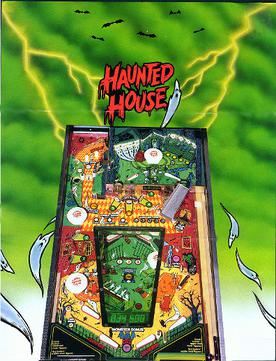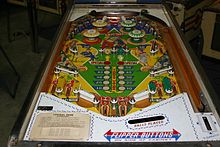
Pinball games are a family of games in which a ball is propelled into a specially designed table where it bounces off various obstacles, scoring points either en route or when it comes to rest. Historically the board was studded with nails called 'pins' and had hollows or pockets which scored points if the ball came to rest in them. Today, pinball is most commonly an arcade game in which the ball is fired into a specially designed cabinet known as a pinball machine, hitting various lights, bumpers, ramps, and other targets depending on its design. The game's object is generally to score as many points as possible by hitting these targets and making various shots with flippers before the ball is lost. Most pinball machines use one ball per turn, and the game ends when the ball(s) from the last turn are lost. The biggest pinball machine manufacturers historically include Bally Manufacturing, Gottlieb, Williams Electronics and Stern Pinball.

Q*bert is an arcade video game developed and published for the North American market by Gottlieb in 1982. It is a 2D action game with puzzle elements that uses isometric graphics to create a pseudo-3D effect. The objective of each level in the game is to change every cube in a pyramid to a target color by making Q*bert, the on-screen character, hop on top of the cube while avoiding obstacles and enemies. Players use a joystick to control the character.

Breakout is an arcade video game developed and published by Atari, Inc. and released on May 13, 1976. It was designed by Steve Wozniak, based on conceptualization from Nolan Bushnell and Steve Bristow, who were influenced by the seminal 1972 Atari arcade game Pong. In Breakout, a layer of bricks lines the top third of the screen and the goal is to destroy them all by repeatedly bouncing a ball off a paddle into them. The arcade game was released in Japan by Namco. Breakout was a worldwide commercial success, among the top five highest-grossing arcade video games of 1976 in both the United States and Japan and then among the top three highest-grossing arcade video games of 1977 in the US and Japan. The 1978 Atari VCS port uses color graphics instead of a monochrome screen with colored overlay.
Exidy, Inc. was a developer and manufacturer of coin-operated electro-mechanical and video games which operated from 1973 to 1999. They manufactured many notable titles including Death Race (1976), Circus (1978), Star Fire (1978), Venture (1981), Mouse Trap (1981), Crossbow (1983), and Chiller (1986). They were also the creators of the Exidy Sorcerer (1978) home computer platform.
Stern is the name of two different but related arcade gaming companies. Stern Electronics, Inc. manufactured arcade video games and pinball machines from 1977 until 1985, and was best known for Berzerk. Stern Pinball, Inc., founded in 1986 as Data East Pinball, is a manufacturer of pinball machines in North America.

Cinematronics Incorporated was an arcade game developer that primarily released vector graphics games in the late 1970s and early 1980s. While other companies released games based on raster displays, early in their history, Cinematronics and Atari, Inc. released vector-display games, which offered a distinctive look and a greater graphic capability, at the cost of being only black and white (initially). Cinematronics also published Dragon's Lair in 1983, the first major LaserDisc video game.

Black Hole is a pinball game released in 1981 by Gottlieb. It is notable for having two playfields: one on top with a conventional slope, and one mounted underneath, sloping away from the player. It has no connection with the 1979 film of the same name.

Haunted House is a pinball game released in October 31 1982 by Gottlieb. It was the first game with three playfields that the ball can move between, including one below the main playing surface. Haunted House was designed by John Osborne, with artwork by Terry Doerzaph. It is part of Gottlieb’s “System 80” series of pinball machines.
Centuri, formerly known as Allied Leisure, was an American arcade game manufacturer. They were based in Hialeah, Florida, and were one of the top six suppliers of coin-operated arcade video game machinery in the United States during the early 1980s. Centuri in its modern inception was formed when former Taito America president Ed Miller and his partner Bill Olliges took over Allied Leisure, Inc. They renamed it "Centuri" in 1980.

Baffle Ball is a pinball machine created on November 19, 1931, by David Gottlieb, founder of the Gottlieb amusement company.
Game Plan was a pinball manufacturer that produced pinball tables from 1978 to 1985. Game Plan was a subsidiary of AES Technology Systems and was located in Elk Grove Village, Illinois. Game Plan's president was former Chicago Coin table designer Wendell McAdams.

Speed Race is a 1974 arcade racing video game developed and manufactured by Taito and released under the titles Racer and Wheels in North America by distributor Midway Manufacturing in 1975. Designed by Tomohiro Nishikado, the gameplay involves the player using the attached steering wheel to maneuver a car alongside a fast vertical scrolling road. The objective is to score points by driving past other cars without colliding with them; more points are awarded for driving faster. Players must do this under a 90-second time limit, which ends the game when it runs out. The gameplay concepts were adapted from two earlier driving electro-mechanical games: Kasco's Mini Drive (1958) and Taito's Super Road 7 (1970).
Electro-mechanical games are types of arcade games that operate on a combination of some electronic circuitry and mechanical actions from the player to move items contained within the game's cabinet. Some of these were early light gun games using light-sensitive sensors on targets to register hits, while others were simulation games such as driving games, combat flight simulators and sports games. EM games were popular in amusement arcades from the late 1940s up until the 1970s, serving as alternatives to pinball machines, which had been stigmatized as games of chance during that period. EM games lost popularity in the 1970s, as arcade video games had emerged to replace them in addition to newer pinball machines designed as games of skill.

Zaccaria, was an Italian company of pinball and arcade machines that existed in Bologna from 1974 until 1990. The factory was sold to tecnoplay.
Playmatic was a Spanish manufacturer of pinball machines, producing approx. 63 different models between 1968 and 1987. Although American pinball manufacturers create playfields by directly painting the artwork on a wooden surface, then add a layer of varnish or clear coat, Playmatic and other European manufacturers included the artwork on a durable plastic sheet laid over the flat wooden surface, resulting in added durability of the artwork image.

Taito of Brazil was a pinball and arcade manufacturer located in São Paulo, Brazil. The company originally started out as Clover Electronic Amusement in 1968, then became Taito of Brazil in 1972 by Abraham "Abba" Kogan, the son of the founder of the parent company Taito located in Japan. This subsidiary was originally an importer of existing U.S. and Japanese machine components to be assembled within the country. However, the taxation on imports had been growing steadily, and the government's belief that pinball is a game of chance and considered a gambling machine, led to strict import rules. By 1976, within rules created by the Electronic Processing Activities Coordinating Committee (CAPRE), it became illegal to import pinball machines. This created a problem, since the popularity of arcade games in Brazil had been growing exponentially for many years.

Spirit of 76 is a pinball game designed by Ed Krynski and Wayne Neyens and released in 1975 by Gottlieb. The pinball machine should not be confused with the pinball machine The Spirit of '76 by Mirco Games, Inc.

Atari Vault is a collection of one hundred video games that Atari had produced for arcade cabinets and its Atari 2600 home console system, dating from the 1970s, 1980s, and 1990s. The collection was developed by Code Mystics, who had helmed similar collections of Atari games to other platforms, to work on Microsoft Windows, macOS, and Linux via the Steam client. The games, where possible, have been updated to include modern-day features such as local and online multiplayer and online leaderboards.

An arcade game or coin-op game is a coin-operated entertainment machine typically installed in public businesses such as restaurants, bars and amusement arcades. Most arcade games are presented as primarily games of skill and include arcade video games, pinball machines, electro-mechanical games, redemption games or merchandisers.














